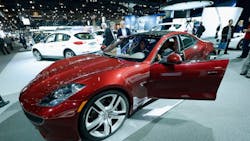Fisker Automotive is Back! – Will Produce Cars in New California Plant
California was very happy this week to announce that Fisker Automotive will build its plug-in hybrid electric vehicle Karma at a new 555,670 square facility in South Moreno Valley Industrial Area.
The company, which was founded in 2007, rolled out its $100,000-plus Karma, built in Finland, in 2011. It had received a $529 million loan commitment from the U.S. Department of Energy to build its hybrid vehicles, as reported by Debra Gruszecki of the Press Enterprise.
However the company ran into battery problems which resulted in a product recall that bankrupted the battery manufacturer, damaged the brand’s reputation and brought production to a halt, as reported by the Los Angeles Times. Fewer than 2,500 of the cars were sold before production ceased in 2012 and in 2013 the company filed for bankruptcy.
As part of the bankruptcy case settlement, Fisker Automotive’s ownership shifted from Hong Kong billionaire Richard Li in 2014 to Wanxiang, a Chinese parts maker with a plan to put the company’s gas-electric hybrid Karma back on the assembly line and introduce lower-cost vehicles by 2017.
The company said it expects to create 150 full-time manufacturing jobs at the start of production.
This investment is part of an ongoing strengthening of the auto sector in California. The editorial board of the Sacramento Bee explained the economic impact.
Fisker’s resurrection, combined with the Tesla factory in Fremont and the excitement around Google’s driverless car project, suggests the emergence of a 21st-century version of California’s once-thriving automotive manufacturing sector.
In January, Ford opened a new research and innovation center in Palo Alto. Last month, Volkswagen announced plans to open a new parts distribution center in Sacramento. Hyundai recently completed a new North American headquarters in Fountain Valley.
It takes some of the sting out of Tesla’s decision to choose Nevada for its battery-making facility and Toyota’s decision to move its North American headquarters to Texas.
California wasn’t Fisker’s only suitor. Texas was in the running. But more and more, California is a natural fit for green companies.
A spokesman at Gov. Jerry Brown’s economic development group, Go-Biz, said the details of the deal are still being worked out. But aside from a break on its utility bills, some help with recruitment and a chance to take advantage of some existing state tax breaks, it appears that Fisker’s decision to locate here had less to do with government incentives than with the chance to locate in its natural market, and near its offices in Orange County.
Imagine: California getting a pivotal gig just because it’s a smart place to do business. If, after all we’ve been through in recent years, we’ve finally achieved that, it’ll be a real victory.
